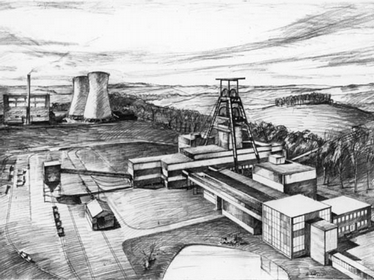The Story of Scottish Coal
Sketch of the reconstructed third shaft at Barony Colliery in Ayrshire, which was completed in the mid-1950s, and included a power station designed to supply electricity to the National Grid
© Crown copyright: RCAHMS, SC706502, c.1955 (Photo: Egon Riss, National Coal Board architect)
© Crown copyright: RCAHMS, SC706502, c.1955 (Photo: Egon Riss, National Coal Board architect)
After the nationalisation of the British coal industry in 1947, there was a desperate need for coal. At the time, almost all energy needs were still provided by coal. This included coal for industry, where it was used to heat buildings, provide heat for many processes, and to generate steam. It was also the main fuel for railway locomotives, and was the source of town gas.
The Government invested heavily in the reconstruction of coal mines in order to produce enough coal to keep Britain working, and as electricity became more important, often built power stations close to coal mines, as was the case here at Barony Colliery in the Ayrshire coalfield to the west of Glasgow.
The Government invested heavily in the reconstruction of coal mines in order to produce enough coal to keep Britain working, and as electricity became more important, often built power stations close to coal mines, as was the case here at Barony Colliery in the Ayrshire coalfield to the west of Glasgow.


